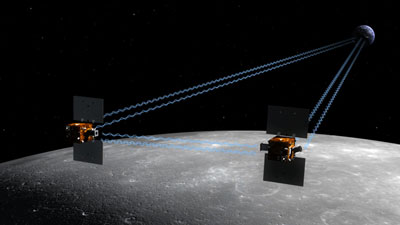Is XSS-11 the answer to America’s quest for Operationally Responsive Space?by Taylor Dinerman
|
| GRAIL is a good example of what NASA can do when it chooses to emphasize high scientific value and low technical and programmatic risk. |
A similar set of measurements from the Moon would permit researchers to learn about the mysterious “mascons”: gravity anomalies that often play havoc with spacecraft in low orbit around Earth’s natural satellite. The pair of satellites, based on the XSS-11 spacecraft built by Lockheed Martin for the Air Force Research Laboratory earlier this decade, will use Ka-band ranging instruments to send signals between one another and then relay the data back to Earth. As with the GRACE project, the scientists will no doubt find new and unexpected ways to use the information.
The XSS-11 spacecraft has proved itself during its 18-month mission. After its launch in April 2005, it repeatedly performed autonomous “rendezvous and proximity maneuvers” that showed it could perform inspection and sophisticated space situational awareness missions at a fairly low cost. The onboard control system proved itself to be reliable and, within the mission’s limits, durable.
The mission was controversial to the extent that some foes of space “weaponization” claimed that it was a precursor to a co-orbital anti-satellite (ASAT) weapon. They are right, of course: any satellite or spacecraft capable of proximity operations or docking is also capable of being used as an kinetic ASAT. What made the XSS-11 special was its relatively low weight and cost ($80 million, including the Orbital Sciences Minotaur launch vehicle) and its potential, according to the Air Force, “to reduce the size and complexity of future space ground stations.” This potential was not lost on NASA.
The basic XSS-11 platform, with its simple thrusters and solar arrays and its proven operations control processors, can be adapted to fill many roles beyond the ones already mentioned. It could carry a hyperspectral instrument or an imaging package tailored for a specific region or application. It could possibly perform close up inspections of space debris or of suspicious satellites. For NASA, it could serve as a platform for a new generation of Earth observation instruments. Its relatively low cost would allow the agency and its partners, such as NOAA, to fly a variety of experimental sensors with having to worry that a failure would have a significant impact on its overall program.
Using the XSS-11 for a mission beyond Earth’s orbit opens up the possibility that it could be used as that long-awaited standard platform for modestly priced solar system exploration missions. It would be nice to see a flow of proposals for XSS-11-based missions to Venus or Mercury, as well as for future missions to comets and asteroids. It is a small craft that weighs only about 100 kilograms; the limits this places on the size and number of instruments that can be carried might be a problem for some mission designers, but this could also provide them with some much needed discipline. Requirements creep is not just a problem for the military, after all.
| The basic XSS-11 platform, with its simple thrusters and solar arrays and its proven operations control processors, can be adapted to fill many roles. |
The original XSS-11 was launched by a Minotaur 1 rocket, based on parts of old ICBMs. This is a nice and fairly easy way to get a package into orbit. In the future launching several of these satellites on top of an Atlas 5 or Delta 4 EELV might be more cost effective. It will be interesting to see what launch vehicle NASA chooses for the GRAIL mission.
America has been lucky to have a number of innovative and highly competent small satellite manufacturers. If the US government were to buy a large number of these Lockheed Martin spacecraft this would, inevitably, cut into the sales of the others. This not only would present the usual problems with the industrial base, but also create political and perhaps even legal problems. However, at some point those who are running the ORS program and the Defense Department as a whole have to decide to fish or cut bait. The NASA decision has given them a great opportunity. The question is, what will they do with it?
